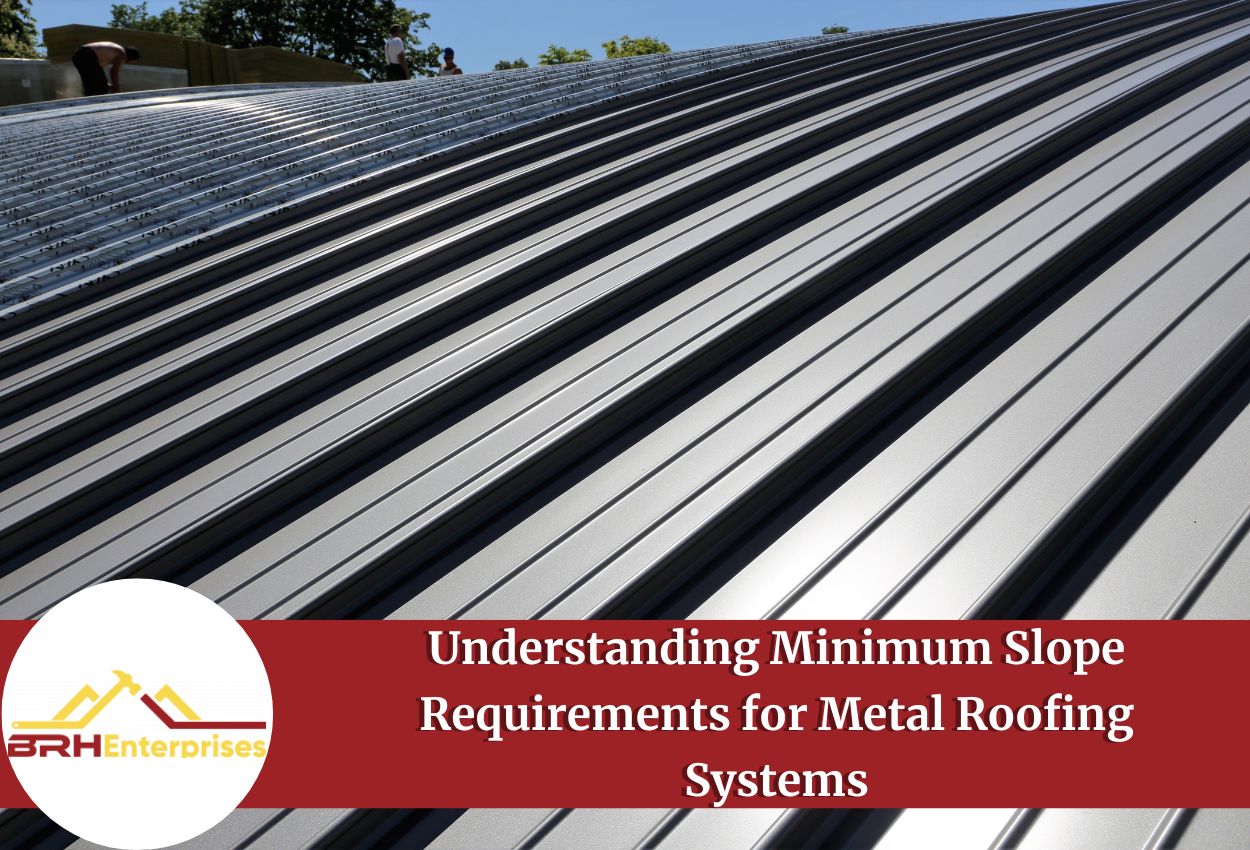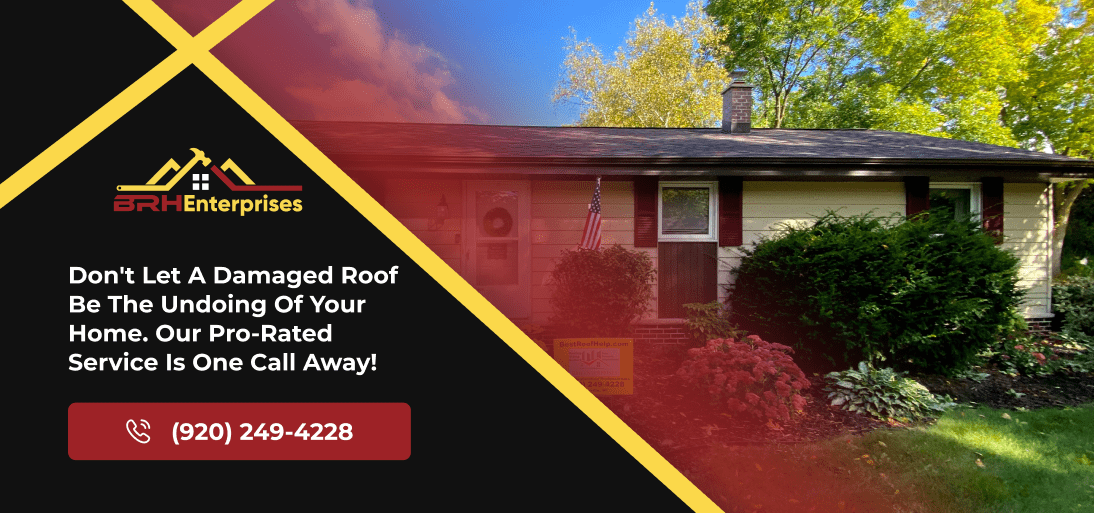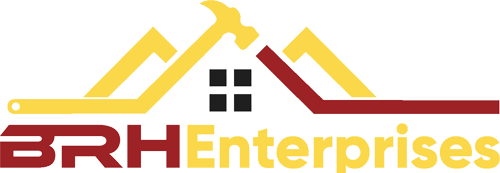Understanding Minimum Slope Requirements for Metal Roofing Systems
Estimated Reading Time : 5 Min.

If you’re considering installing a metal roof, it’s essential to understand an important aspect of the process – slope. The roof slope affects how your roof will react to different weather conditions in Wisconsin. A metal roof with a steep slope will shed water and snow easily. On the other hand, a metal roof with a lower slope will provide you with a flatter roof. To make the right decision for your property, it is essential to understand the minimum slope for metal roofs.
In this comprehensive guide, we’ll delve into the slope requirements for metal roofing systems, providing you with the information you need to make informed decisions and ensure your metal roof lasts for years to come.
Understanding Roof Slope
Before we dive into specifics, let’s clarify what exactly we mean by metal roof slope. In simple terms, the slope of a roof refers to its pitch or incline. It’s the angle at which the roof surface rises in relation to its horizontal base. Roof slope is generally expressed as a ratio, such as 4:12, 6:12, or 8:12, which represents how many inches the roof rises vertically for every 12 inches it extends horizontally.
Roof slope is an important factor that significantly contributes to the roof’s durability, lifespan, energy efficiency, and weather resistance. So, if you are going to install a new roof, understanding the minimum slope for metal roofs can help you decide which roofing system is best. Though skilled roofers know the minimum slope required for metal roofing systems, by reading this blog post you will know what to expect and can ask the appropriate questions during installation.
Also Read: When It Comes To Metal Roofing Systems, Here’s What 2023 Has In Store
Why Does Slope Matter For Your Metal Roof?
Understanding the importance of metal roof slopes is crucial because it directly impacts various aspects of your roofing project. Here are some key reasons why slope matters:
1. Water Drainage
Proper water drainage is essential to protect your roof from ponding. The accumulated water can lead to leaks, damage, and even structural issues over time. The slope of your metal roof plays a pivotal role in ensuring efficient water drainage and directing rainwater away from your home’s foundation.
A low-slope metal roof can’t effectively shed water, so they aren’t recommended for residential or many commercial settings. Meanwhile, steep or medium-slope metal roofs can efficiently guide water to the drainage system.
2. Weather Resistance
Homeowners install metal roofs for their exceptional weather resistance. A well-designed slope enhances this by shedding snow, ice, and debris more effectively. This helps prevent the build-up of heavy loads on your roof during winter and minimizes the risk of damage. Moreover, metal roofs with the right slope are more energy efficient than those with a low slope.
3. Aesthetic Appeal
The slope of your metal roof plays a pivotal role in creating your home’s overall look. The slope of your metal roof can enhance its aesthetic look and curb appeal, increasing your home’s resale value. Different slopes create distinct architectural styles, from a classic gabled roof to a sleek, modern hip roof. Choosing the right slope can enhance the overall aesthetics of your home.
Common Roof Slopes
While there’s no one-size-fits-all answer to the ideal metal roof slope, here are some common slope ranges widely used in roofing projects:
1. Low Slope (1/4:12 to 3:12)
Though roofs with steep slopes increase the aesthetics of a building, a low slope is suitable for regions with mild climates and minimal rainfall. It offers a modern, sleek appearance and can work well with contemporary architectural styles.
2. Moderate Slope (4:12 to 8:12)
Moderate roof slope is versatile and is often chosen for the aesthetics and functionality they provide. It provides efficient water runoff while allowing for various design options.
3. Steep Slope (8:12 and higher)
A steep slope is ideal for areas with heavy rain or snow. It offers excellent water drainage and a classic, timeless look.
The Minimum Slope Required for Metal Roofing Systems
The ideal slope for a metal roof primarily depends on the type of metal roofing material you choose. Different metal roof styles have varying requirements to ensure proper water drainage and prevent potential issues. Here are the minimum slope recommendations for some common metal roofing systems:
1. Standing Seam Metal Roof
Standing seam metal roofing is known for its sleek, modern appearance. The required minimum slope for standing seam metal roofs is 1/4:12 (1/4 inch of vertical rise for every 12 inches of horizontal run), and this is generally recommended. However, some manufacturers may specify a slightly steeper slope, so it’s essential to consult their guidelines.
2. Corrugated Metal Roof
Corrugated metal roofs are a cost-effective and durable option. Similar to standing seam metal roofs, the required minimum slope for corrugated metal roofs is 1/2:12. This relatively low slope makes it suitable for a wide range of applications.
3. Metal Shingles
Metal shingles, designed to mimic the appearance of traditional roofing materials, require a slightly steeper slope of at least 4:12. The specific slope will depend on the manufacturer’s recommendations and the design of the shingles.
4. Metal Tiles
Metal tiles offer a classic and elegant look. They typically require a minimum slope of 3:12 to 4:12, similar to metal shingles. Always check with the manufacturer for their specific slope requirements.
Also Read: Metal vs. Slate Roofing: Which One Is Best For Your Home?
How To Choose The Right Metal Roof Slope
Determining the ideal slope for your metal roof involves several factors, including your location, climate, roof design, and personal preferences. Here’s a closer look at these considerations:
1. Climate
If you want to choose the right metal roof slope, considering the local climate is the essential first step. In areas with heavy rainfall or snowfall, like Wisconsin, a steeper slope is often recommended. Conversely, in regions with milder climates, a shallower slope may work.
2. Roof Design
The design and profile of your roof also play a significant role. A simple gable roof will have a different slope compared to a complex hip roof. Additionally, the slope can vary within the same roof structure if you have sections with different designs.
3. Style Compatibility
The type of metal roof you choose can influence your slope requirements. For example, standing seam metal roofs are versatile and can work well with various slopes, while some roofs, as discussed above, have specific requirements.
4. Building Codes
Local building codes may have specific minimum slope requirements for metal roofs. Ensure that your chosen slope complies with your local building regulations.
5. Maintenance
Roofs have different maintenance requirements depending on the slope chosen. Steeper slopes may require less maintenance due to their superior water-shedding capabilities, while a low-slope metal roof may require additional maintenance to remove the pooled water or debris from the surface. However, regardless of your slope choice, maintenance, and regular inspections are a must for all types of roofs.
6. Roofing Contractor
Consult an experienced roofing contractor to assess your specific needs and for guidance on the optimal slope for your metal roof. If you live in Wisconsin, you can call the skilled and expert roofers at BRH Enterprises.
7. Personal Preferences
In the end, your preferences matter. If you aren’t satisfied with a medium slope roof with metal tiles, it is completely up to you to custom-fit your roof slope. Some homeowners prefer the classic look of a steeply pitched roof, while others opt for a flatter, more modern appearance.
Final Thoughts
Understanding the slope of metal roofs is essential before starting a roofing project. It impacts water drainage, weather resistance, and the overall aesthetics of your home. By considering your climate, roof design, material compatibility, and personal preferences, you can select the ideal slope that not only enhances the functionality of your roof but also complements your home’s style.
Consult Skilled And Professional Roofers In Wisconsin About Your Metal Roof Slope
Are you considering installing a metal roof on your home or commercial building in Wisconsin? If yes, you have come to the right page.
The skilled and experienced roofers at BRH Enterprises in Wisconsin can guide you through choosing the right metal roof slope and installing a durable roofing system. The team are experts in numerous roofing services, including metal roof installation, complete roof replacements, roof repair, and roof inspection. Contact us today at (920) 249-4228 about your metal roof installation.


